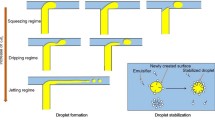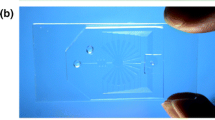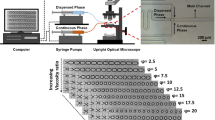Abstract
Formation of emulsion droplets is crucial for a variety of industrial and scientific applications. This study presents a new droplet-based microfluidic system capable of generating tunable and uniform-sized droplets and subsequently deflecting these droplets at various inclination angles using a combination of flow-focusing and moving-wall structures. A pneumatic air chamber was used to activate the moving-wall structures, located nearby the outlet of the flow-focusing microchannels, such that the sheath flows can be locally accelerated. With this approach, the size of the droplets can be fine-tuned and sorted without adjusting the syringe pumps. Experimental data showed that droplets with diameters ranging from 31.4 to 146.2 μm with a variation of less than 5.39% can be generated. Besides, droplets can be sorted upwards or backwards with an inclination angle ranging from 0° to 53.5°. The development of this emulsion system may be promising for the formation and collection of emulsion products for applications in the pharmaceutical, cosmetics and food industries.












Similar content being viewed by others
Abbreviations
- CCD:
-
Charge-coupled device
- CV:
-
Coefficient of variation
- EMV:
-
Electromagnetic valve
- MEMS:
-
Micro-electro-mechanical-systems
- PDMS:
-
Polydimethylsiloxane
- P 1 :
-
Air pressure injected to the upper moving-wall
- P 2 :
-
Air pressure injected to the lower moving-wall
- SEM:
-
Scanning electron microscope
- V 1 :
-
Sample flow velocity
- V 2 :
-
Sheath flow velocity
- o/w:
-
Oil-in-water
- w/o:
-
Water-in-oil
- o/w/o:
-
Oil-in-water-in-oil
- w/o/w:
-
Water-in-oil-in-water
- δ1 :
-
Deformation of the upper moving-wall
- δ2 :
-
Deformation of the lower moving-wall
- θ:
-
Inclination angle of emulsion droplets
- φ:
-
Outlet angle of the orifice
References
Anna SL, Bontoux N, Stone HA (2003) Formation of dispersions using ‘flow-focusing’ in microchannels. Appl Phys Lett 82:364–366
Charcosset C, Limayem I, Fessi H (2004) The membrane emulsification process—a review. J Chem Technol Biotechnol 79:209–218
Chen CT, Lee GB (2006) Formation of micro-droplets in liquids utilizing active pneumatic choppers on a microfluidic chip. J Microelectromechs Syst 15:1492–1498
Christov NC, Ganchev DN, Vassileva ND, Denkov ND, Danov KD, Kralchevsky PA (2002) Capillary mechanisms in membrane emulsification: oil-in-water emulsions stabilized by Tween 20 and milk proteins. Colloid Surf A Physicochem Eng Asp 209:83–104
Garstecki P, Gitlin I, DiLuzio W, Whitesidesa GM (2004) Formation of monodisperse bubbles in a microfluidic flow-focusing device. Appl Phys Lett 85(13):27
Hsiung SK, Chen CT, Lee GB (2006) Micro-droplet formation utilizing microfluidic flow focusing and moving-wall chopping techniques. J Micromech Microeng 16:2403–2410
Huang CW, Huang SB, Lee GB (2006) Pneumatic micropumps with serially connected actuation chambers. J Micromech Microeng 16:2265–2272
Jafari SM, He Y, Bhandari B (2006) Nano-emulsion production by sonication and microfluidization—a comparison. Int J Food Prop 9:475–485
Lee GB, Hung CI, Ke BJ, Huang GR, Hwei BH (2001a) Micromachined pre-focused 1 × N flow switches for continuous sample injection. J. Micromech Microeng 11:567–573
Lee GB, Hwei BH, Huang GR (2001b) Micromachined pre-focused M × N flow switches for continuous multi-sample injection. J Micromech Microeng 11:654–661
Lee CH, Hsiung SK, Lee GB (2007) A tunable microflow focusing device utilizing moving-wall structures and its applications for formation of micro-droplets in liquids. J Micromech Microeng 17:1121–1129
Nisisako T, Torii T (2008) Microfluidic large-scale integration on a chip for mass production of monodisperse droplets and particles. Lab Chip 8:287–293
Nisisako T, Torii T, Higuchi T (2002) Droplet formation in a microchannel network. Lab Chip 2:24–26
Okushima S, Nisisako T, Torii T, Higuchi T (2004) Controlled production of monodisperse double emulsions by two-step droplet breakup in microfluidic devices. Langmuir 20:9905–9908
Sugiura S, Nakajima M, Iwamoto S, Seki M (2001) Interfacial tension driven monodispersed droplet formation from microfabricated channel array. Langmuir 17:5562–5596
Sugiura S, Nakajima M, Kumazawa H, Iwamoto S, Seki M (2002a) Characterization of spontaneous transformation-based droplet formation during microchannel emulsification. J Phys Chem 106:9405–9409
Sugiura S, Nakajima M, Seki M (2002b) Prediction of droplet diameter for microchannel emulsification. Langmuir 18:3854–3859
Takeuchi S, Garstecki P, Weibel DB, Whitesides GM (2005) An axisymmetric flow-focusing microfluidic device. Adv Mater 17:1067–1072
Tan YC, Lee AP (2005) Microfluidic separation of satellite droplets as the basis of a monodispersed micron and submicron emulsification system. Lab Chip 6:1178–1183
Tan YC, Cristini V, Lee AP (2005) Monodispersed microfluidic droplet generation by shear focusing microfluidic device. Sens Actuators B 114:350–356
Tan YC, Cristini C, Lee AP (2006) Monodispersed microfluidic droplet generation by shear focusing microfluidic device. Sens Actuators B 114:350–356
Xu Q, Nakajima M (2004) The generation of highly monodisperse droplets through the breakup of hydrodynamically focused microthread in a microfluidic device. Appl Phys Lett 85:3726–3728
Xu S, Nie Z, Seo M, Lewis P, Kumacheva E, Stone HA, Garstecki P, Weibel DB, Gitlin I, Whitesides GM (2005) Generation of monodisperse particles by using microfluidics: control over size, shape, and composition. Angew Chem Int Ed Engl 44:724–728
Xu JH, Li SW, Tan J, Wang YJ, Luo GS (2006a) Controllable preparation of monodisperse O/W and W/O emulsions in the same microfluidic device. Langmuir 22(19):7943–7946
Xu JH, Li SW, Tan J, Wang YJ, Luo GS (2006b) Preparation of highly monodisperse droplet in a T-junction microfluidic device. AIChE J 52(9):3005–3010
Yobas L, Martens S, Ong WL, Ranganathan N (2006) High-performance flow-focusing geometry for spontaneous generation of monodispersed droplets. Lab Chip 6:1073–1079
Zhou C, Yue P, Feng JJ (2006) Formation of simple and compound drops in microfluidic devices. Phys Fluids 18(092105):1–14
Acknowledgments
The authors would like to thank the National Science Council in Taiwan for their financial support (NSC 96-2120-M-006-008).
Author information
Authors and Affiliations
Corresponding author
Rights and permissions
About this article
Cite this article
Lee, CY., Lin, YH. & Lee, GB. A droplet-based microfluidic system capable of droplet formation and manipulation. Microfluid Nanofluid 6, 599–610 (2009). https://doi.org/10.1007/s10404-008-0340-2
Received:
Accepted:
Published:
Issue Date:
DOI: https://doi.org/10.1007/s10404-008-0340-2




